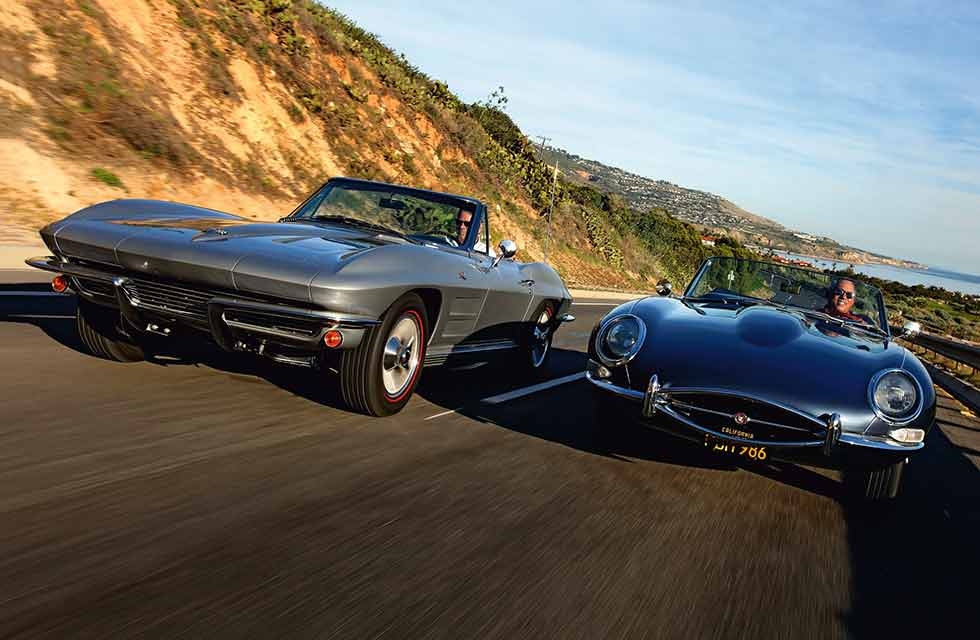
‘Let’s race all the way to Dead Man’s Curve… Reviving a bitter transatlantic rivalry that played out on the streets – and in the charts – of ’60s America. Words Greg Macleman. Photography James Man.
Transatlantic Tussle E-Type vs. Corvette – Jaguar takes on Chevrolet in our transatlantic shootout
Greg MacLeman picks from American V8 muscle and thoroughbred British ‘six’
‘Each downshift from the Jaguar pierces the blanket of noise coming from the rumbling 327cu in V8 in the nose of the Corvette’
I was cruising in my Sting Ray late one night, when an XK-E pulled up on the right…’ The radio is tuned in to a local station playing the latest country hit to top the charts, but all I can hear is Dead Man’s Curve. Even the rumble of the Chevy’s 327cu in V8 can’t drown out the lyrics swimming through my mind as we chase the metallic blue E-type through the hills of Palos Verdes, just south of Los Angeles. Each downshift from the Jaguar pierces the blanket of noise coming from the nose of the Corvette, and every time I feel myself being transported to the early ’60s and the Anglo-American tussle between these two legends, both on dealer forecourts and away from the lights.
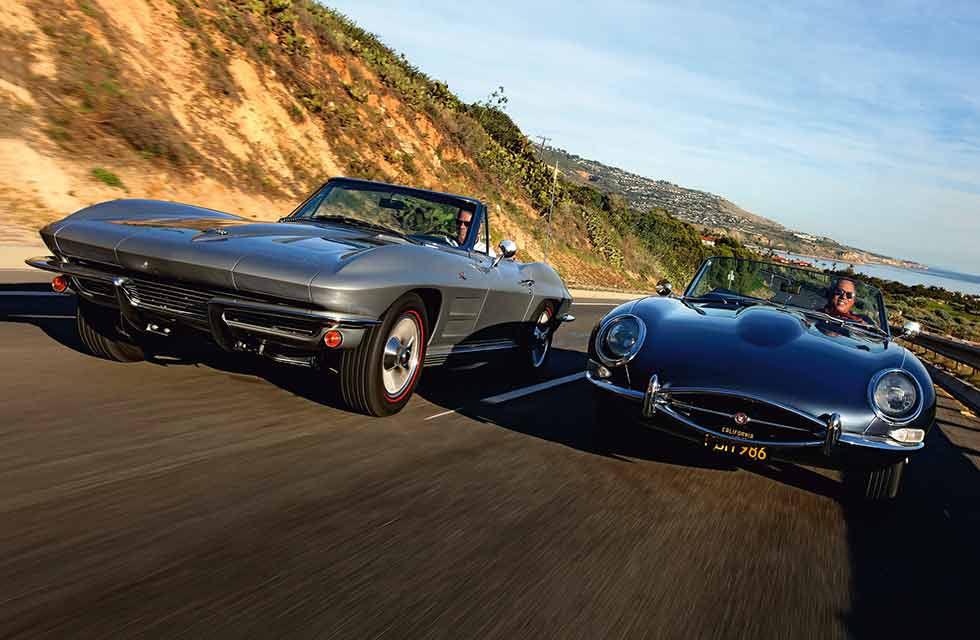
Jan Berry and Dean Torrence’s hit song mythologising a full-blooded – and ultimately ill-fated – street race through Los Angeles might have been a flight of fancy, but it’s a scene that was surely witnessed all across the United States following the launch of these deadly rivals.
American buyers weren’t exactly spoiled for choice when it came to high-performance sports cars, so for many buyers the decision would have been between the costly yet exotic E-type, with its achingly beautiful bodywork, and the hometown hero Sting Ray, introduced for the 1963 model year.
The Jaguar reached the shores of southern California first, shortly after being revealed to much fanfare at the Geneva motor show in 1961. A claimed top speed of 150mph grabbed the headlines, but the excitement was as much to do with an organic shape that shied away from straight lines and flat surfaces, and which bore a striking familial resemblance to stylist Malcolm Sayer’s greatest achievement, the multiple Le Mans-winning D-type. Though it was not designed as a racer, the similarities between the E-type – or XK-E, as it was known in the States – and its forebear were more than skin-deep.
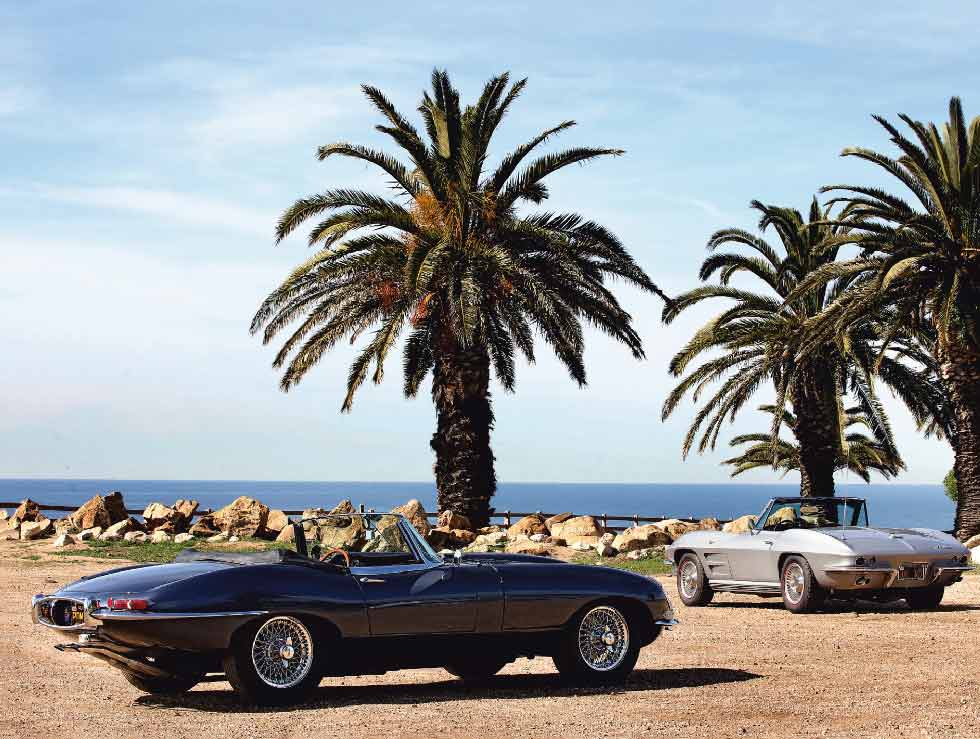
The most notable gift from the D-type programme was the racer’s revolutionary construction, a lightweight monocoque that provided incredible strength and rigidity compared with the earlier separate-chassis XKs.
Manufactured almost entirely of 20-gauge steel, the E-type’s load-bearing shell was formed of several strong box sections reinforced by a hollow member that passed from one side of the car to the other ahead of the four-coil rear suspension. At the front, beneath the three-piece clamshell bonnet, lay a network of welded and bolted lightweight Reynolds 541 tubing that formed a subframe into which the engine and front suspension were mounted.
‘The Sting Ray is more sledgehammer than sabre, less delicate but every inch as striking – the P-51 Mustang to Britain’s Spitfire’
And what an engine! One of the few main components of the new E-type that wasn’t bespoke, the XK powerplant first made an appearance in the XK120 in 1948 and remained in production for more than four decades. By the time it found a home in the E-type, the William Heynes-designed, double-overhead-camshaft straight-six had evolved into its largest capacity yet – 3781cc – and was fitted with a straight-port aluminium cylinder head with equal 35º angles on the exhaust and inlet valves, to the same specification as the XK150S. The result was a peak power output of 265bhp, with 260lb ft of torque – enough to (allegedly) take the slippery E-type beyond 150mph in fixed-head coupé trim and turn in a sub-7 secs sprint to 60mph.
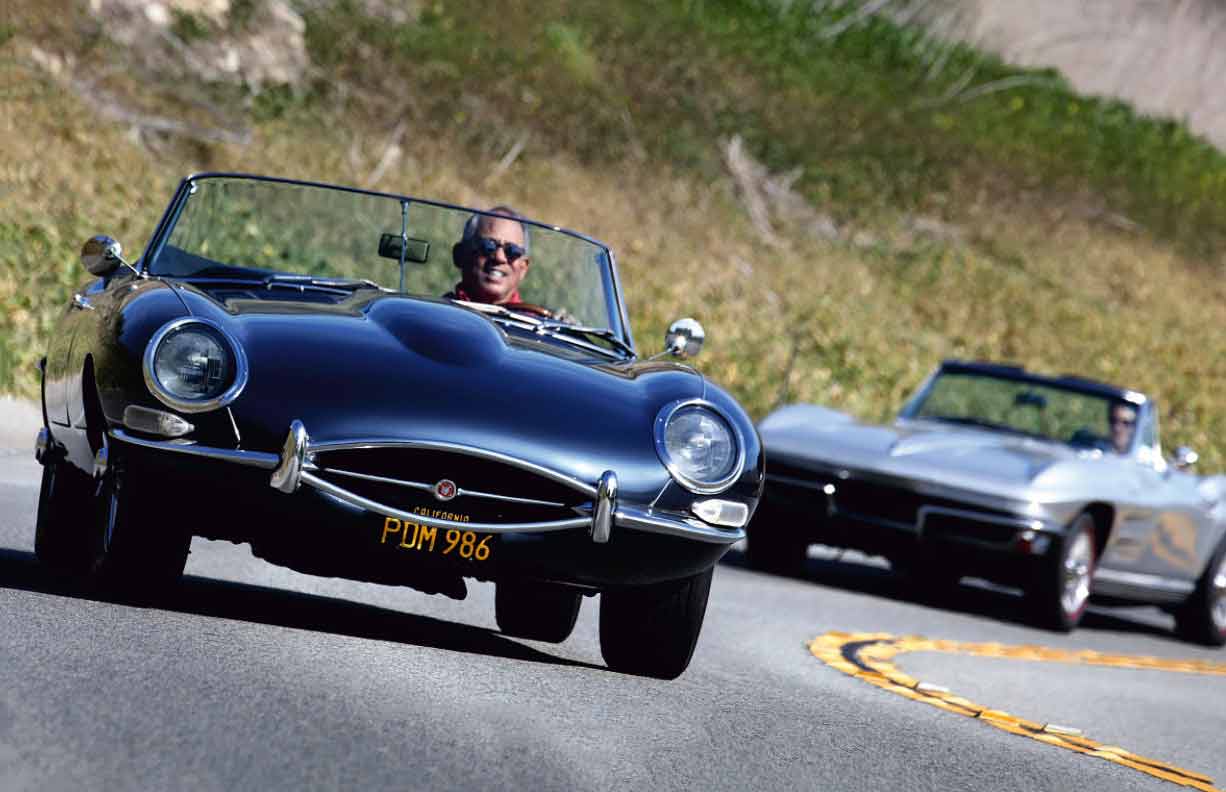
The new sports car was an enormous hit in Britain, but it’s telling that for the first four months of its life the model was built for export only. The lion’s share headed straight to the USA, to a public whose appetite for British sports cars had first been whetted by the MG TC and later stoked by the glamourpuss XK120 – a favourite of film stars such as Clark Gable, Humphrey Bogart and Tyrone Power. It’s a market that Jaguar founder and figurehead William Lyons had firmly in his sights.
American buyers wanting to shop closer to home had only the C1 Corvette as an alternative, which by the turn of the decade was very much showing its age. While it had been steadily improved throughout its lifetime, most notably with the addition of a 265cu in V8 engine in 1955, the antiquated live rear axle and ageing suspension set-up let it down in the handling department. Coupled with that, the styling was stuck firmly in the 1950s, and no number of subtle tweaks, extra headlamps or side scallops could hide what was a decade-old design.
By the time the Jaguar was announced, work was already well under way on the first Corvette’s replacement, led by Chevrolet design chief Bill Mitchell and Ed Cole, who with engineer Zora Arkus-Duntov had given the tame C1 teeth. Both Mitchell and Cole were fans of European sports cars, and Coventry’s Big Cats in particular. Like the E-type, which owed much of its DNA to its competition-bred predecessor, the new Corvette began life on the track.
After Chevrolet’s withdrawal from racing, following the Automobile Manufacturers’ Association’s 1957 dictat that motorsport was becoming too dangerous, Mitchell privately funded a secret race-car project dubbed the ‘Stingray’. Based on the $500 chassis from the 1957 Corvette SS – a sports-racer that ran briefly at Sebring before being consigned to test-track duties – the open car proved hugely successful in the hands of Dick Thompson, winning an SCCA National Championship in 1960 and going on to serve as inspiration for the upcoming C2. Credit for its futuristic bodywork lay with Pete Brock, and it shared many cues with the stillborn 1957 Q-Corvette prototype – which in turn reflected Mitchell’s earlier trip to Turin and the Abarths and Alfa Romeos he saw there. When Brock was moved on to a different project, however, responsibility for translating the racer’s design into the new 1963 Sting Ray coupe, and later the roadster, fell to GM’s Larry Shinoda.
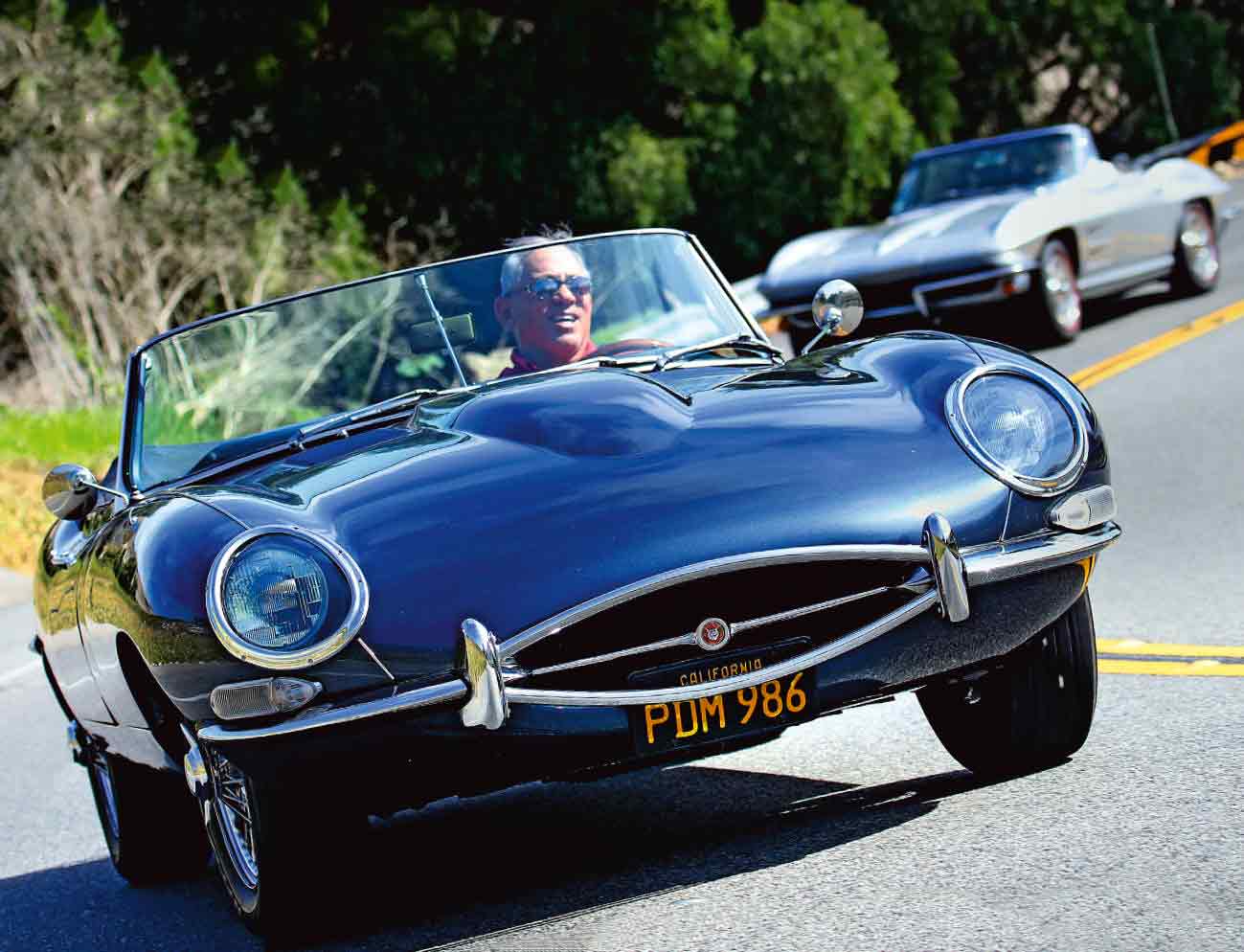
Only the first 300 C1 Corvettes were meant to be glassfibre-bodied, but it proved such a hit that the anticipated change to steel never happened and this trait was carried over to the new model.
Among the improvements for 1963 was a new ladder-frame chassis that did away with the old car’s cross-bracing, while also being lighter and boasting greater torsional rigidity – though the weight saving was gobbled up by a heavier shell that included nearly twice the amount of steel bracing as the original. Perhaps the biggest change took place beneath the svelte new body, with rear suspension that bore an eerie similarity to that of the new E-type. Duntov canned the live rear axle and replaced it with a multi-link arrangement using trailing arms and halfshafts that played the role of upper wishbones. Where the Corvette differed from the Jaguar, however, was in the intriguing use of a transverse leaf spring; cost no doubt played a part here, but so did space – there simply wasn’t the room to fit coils. Chevy’s bottom line was aided by carrying over the C1’s 327cu in V8 and selection of manual and Powerglide auto transmissions.
‘The crisp exhaust note and the gurgle of the SUs greedily drawing at the warm air are all the encouragement you need’
The Sting Ray is a small sports car by American standards, but while it’s dwarfed by the mid- and full-sized sedans of the period – and even its predecessor – there’s no escaping the long nose that dominates the view ahead. The cabin is comfortable if not hugely spacious, and the dashboard echoes the original C1 with two arcing cowls ahead of driver and passenger. There’s a sense of innocence to the Corvette’s ignition, which doesn’t need a key to fire, rather a half-turn of the housing. A few churns of the lazy starter and the small-block V8 catches with a woofly bark before settling to a relaxed, feet-on- the-table-and-arms-behind-your-head idle. It’s a car without a care in the world, and that sense of chilled-out ease is catching: it’s almost impossible not to reach for your shades before slotting the gear selector into Drive.
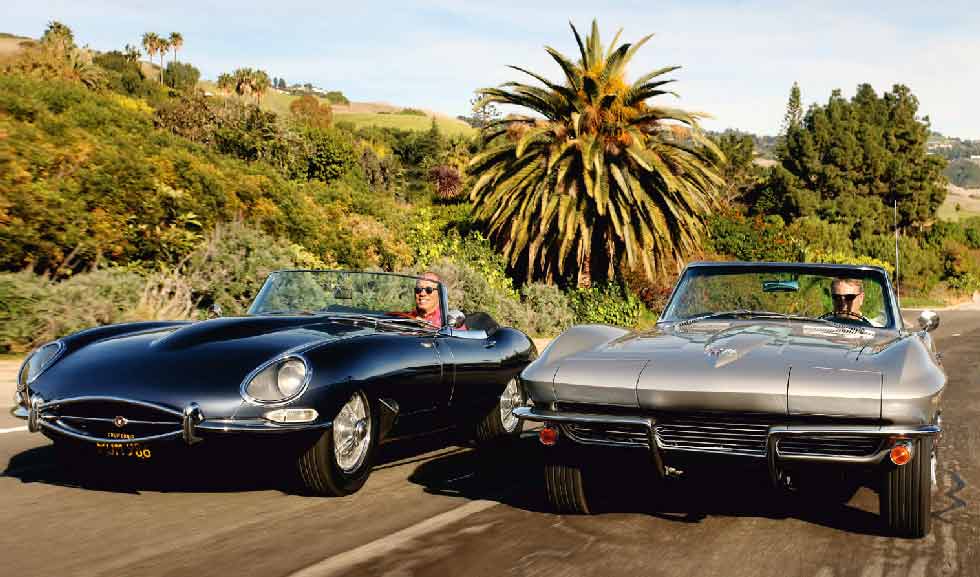
The Powerglide fitted to Ray Lewis’ car in lieu of the entry-level three-speed manual was a cost option only available on base and L75 engines, while by 1964 an optional all-synchro four-speed manual was available for all models, no longer just the more powerful L76 and L84 versions. In truth, ‘our’ 300bhp car doesn’t suffer much for its slushbox: the manual isn’t the pudding-mixer you might expect, instead having a positive gate with little vagueness, but it doesn’t offer much feel and with such prodigious torque, even in base 250bhp trim, the ‘stick’ Sting Ray rarely calls on you to make a change.
Anyone who’s driven a first-gen Corvette will approach their first corner in a C2 with sweaty-palmed trepidation, but the ’Vette quickly proves itself a more reassuring steer, with considerably less free-play at the wheel than its predecessor and more feel as it weights up. Rather than the original model’s steering box, the 1963 version was fitted with a more modern recirculating-ball arrangement, with tapered holes for each steering arm that allow owners to pick between 3.4 turns lock to lock and a quicker ratio with half a turn less. This car’s powered set-up feels fast and responsive, though keep-fit fans may prefer the manual version, whose higher ratio at least lightens the wheel at parking speeds.
‘The Sting Ray is at its best going in a straight line, but it’s no one-trick pony: show it a corner and it’ll likely surprise you’
But the Sting Ray is undeniably at its best going in a straight line, where its bellowing V8 is allowed to do its work uninterrupted. Plant the throttle and it blasts off the line, holding low gear until around 56mph when it really hits its stride. That’s not to say it’s a one-trick pony – show it a bend and it’ll likely surprise you with its cornering ability and impressive grip – but while it’s certainly composed, it isn’t particularly civilised. Rough surfaces or sudden changes in camber elicit plenty of bumps and clonks from an undercarriage that at times feels detached from the rest of the car, with a slight ‘walking’ sensation from the independent rear.
It performs much better on smooth American blacktop, where you can kick out the back end with a bit more confidence. Keep leaning on it and the rear wheels break away with reassuring predictability, helped by an improved 48:52 front-to-rear weight distribution. The model gained four-wheel disc brakes in 1965, but the beefy truck-derived hydraulic drums fitted to earlier cars do a decent enough job of pulling up the Sting Ray’s 3000lb-plus weight.
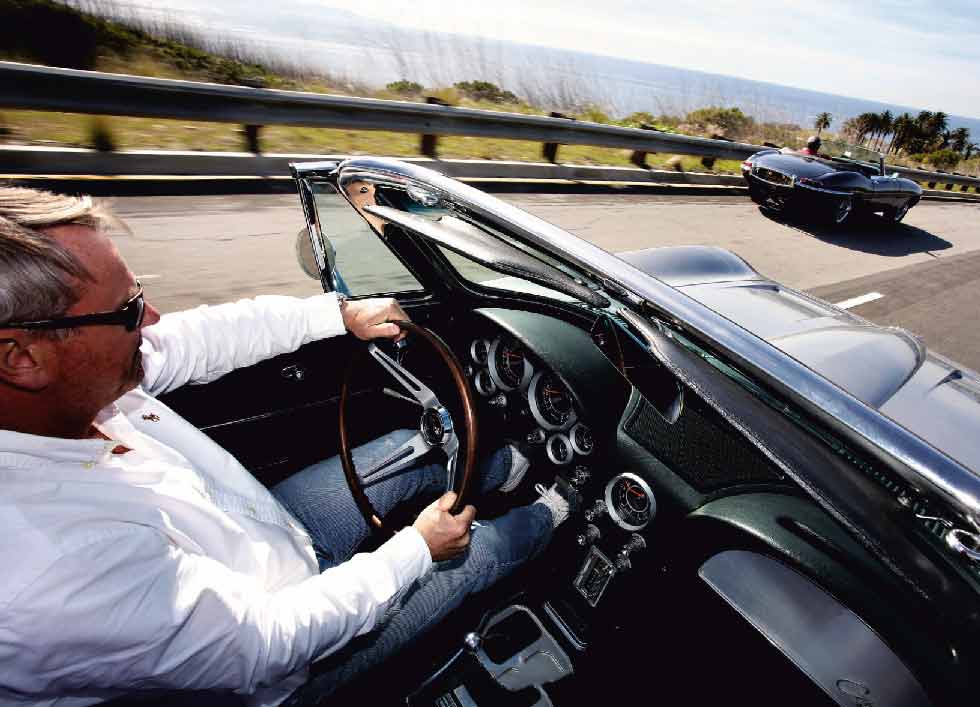
Jump behind the wood-rimmed wheel of Sandor Mayuga’s E-type and it immediately feels the smaller car, despite the panoramic view over that torpedo-like blue bonnet. Like the Corvette it fires up easily, its big straight-six producing a wonderful baritone burble in reply to the booming American V8. The four-speed Moss ’box is a seasoned campaigner whose quirks – no synchro on first and a preference for changes measured in days rather than seconds – are well documented, but with familiarity comes confidence. Take your time swapping ratios and the action is a delight. The automatic in the Chevy certainly has its charms, but the extra involvement demanded by the Jaguar straight away makes it a more engaging drive, with the crisp exhaust note and the gurgle of the triple SUs greedily drawing at the warm California air all the encouragement you need to press on.
Level the right pedal and power builds exponentially. It doesn’t quite match the big V8’s sense of urgency from a standing start, but the Smiths gauges tell a different story further down the road, the lighter kerbweight helping under hard acceleration and the superior aerodynamics lending stability at speed. It’s difficult to imagine an engine that excels at quite so much, whether rumbling along at tickover, spinning beyond 5000rpm on an open road, or taking advantage of its wide powerband and meaty torque on the twisting hill routes of Palos Verdes.
Now, as in 1963, it takes a bigger cheque to put an E-type on your driveway, but with it come some useful improvements over the Corvette – among them sharp rack-and-pinion steering and all-round Dunlop disc brakes boosted by an American Kelsey Hayes servo. Both come into their own when you really stretch the Jaguar’s legs, and it’s soon carving up long sweepers with a capability the Chevy can only dream of. Firm suspension, a taut chassis and near perfect balance complete the package, and if it weren’t for small details – such as daylight, the falling fuel gauge and the fact that this car belongs to someone else – we could be out here for hours. The heady days of Jan and Dean’s street races down Sunset Boulevard are now a thing of the past, but the rivalry between these classics has stood the test of time. Which would win a real drag through downtown LA very much depends on the Corvette. The smart money would probably bring a 375bhp fuel-injected four-speed to the fight. Of our duo today, the E-type has the edge. Its lightness makes up for the power deficit, and by 60mph it will have put a good half a second of clean air between its twin pipes and the chasing Sting Ray. Keep it buried and the XK will run out of breath some 25mph later than the Chevy. So much for ‘all the Jag could see were my six tail-lights’ (adding to the factory quartet was a popular period mod).
But there’s more to these cars than straight-line speed. The Jaguar is one of the most beautiful machines to ever put rubber to road, a fitting encore to the mesmerising D-type, with the roadholding and dynamics to match. The Sting Ray is more sledgehammer than sabre, less delicate in styling but every inch as striking – the P-51 Mustang to Britain’s Spitfire.
For me, it’s difficult to see beyond the Jaguar’s intoxicating blend of looks, glorious straight-six and sporting handling. But if your heart beats for the theatre of a big eight-banger, then in droptop configuration the C2 Corvette provides the perfect stage. A model of cost-effective simplicity, America’s sports car managed to be far greater than the sum of its parts. Chevrolet and Jaguar might have taken different routes, but they each arrived at the same destination, having created a pair of true icons.
Thanks to Mark Mayuga, Jaguar Owners’ Club of Los Angeles; Tom Falconer; Martin Brewer
Right, from top: 3.8-litre ‘six’ wears non-standard air filters; entry-level 327 V8 came in seven states of tune, with 396 and 427cu in big-blocks also available. Jan and Dean’s XK-E met a sticky end through Dead Man’s Curve, but Mayuga’s lovely S1 shows the Corvette a clean pair of heels. Shark-like shape was arrived at by the joint efforts of Mitchell, Brock and Shinoda, but makes a coherent whole. ‘Double-hump’ dash is a development of the C1 style. Below left: crossed flags show chequer, Chevy bowtie and Fleur de Lis. Vette’s turbine-style alloys contrast with classic Jag wires. Distinctive crackleblack finish so familiar to fans of British sports cars in E-type’s snug, well-equipped cockpit.
Chevrolet Corvette Sting Ray C2
Sold/number built 1963-’1967/117,964
Construction steel perimeter frame, glassfibre body
Engine all-iron, ohv 5356cc V8, four-barrel Carter AFB carburettor
Max power 300bhp @ 5000rpm
Max torque 360lb ft @ 3200rpm
Transmission two-speed automatic, driving rear wheels
Suspension independent, at front by unequal length wishbones, coil springs, anti-roll bar rear transverse leaf spring, lower links, trailing arms; telescopic dampers f/r
Steering recirculating ball, optional power assistance
Brakes drums
Length 14ft 7 ¼ in (4450mm)
Width 5ft 9 ½ in (1765mm)
Height 4ft 1 ¾ in (1264mm)
Wheelbase 8ft 2in (2490mm)
Weight 3050lb (1383kg)
0-60mph 7.5 secs
Top speed 124mph
Mpg 14.8
Price new $4040
Price now £35,000-75,000
Jaguar E-Type 3.8 S1
Sold/number built 1961-’1968/17,375
Construction steel monocoque with tubular front subframe
Engine iron-block, alloy-head, dohc 3781cc straight-six, triple SU HD8 carburettors
Max power 265bhp @ 5500rpm
Max torque 260lb ft @ 4000rpm
Transmission Moss four-speed manual, no synchro on first, driving rear wheels
Suspension independent, at front by double wishbones, coil springs, telescopic dampers, anti-roll bar rear lower links, driveshafts as upper links, twin coil/damper units
Steering rack and pinion Brakes discs, with servo
Length 14ft 7 ¼ in (4450mm)
Width 5ft 4 ¼ in (1660mm)
Height 3ft 11in (1190mm)
Wheelbase 8ft (2440mm)
Weight 2650lb (1202kg)
0-60mph 6.9 secs
Top speed 149mph
Mpg 17.9
Price new $5580
Price now £80,000-140,000
Ray Lewis
CHEVROLET CORVETTE
“I always wanted a Corvette,” says Ray Lewis. “Even when I was a child I knew I was going to have a Sting Ray.” The opportunity to get his dream car finally presented itself in late 2019, when he made contact with the first owner of this silver ’1964 327/300. “It was originally delivered to Harry Mann Chevrolet in Los Angeles, which at that time was the largest Corvette dealer in the world,” explains Lewis. “It only had a few options – power windows, back-up lights and a hardtop.
“It had been in the same family since new, but the dad was getting old and the car was getting tired, so the children restored it for him. It had a body-off rebuild in 2010 – the underside is beautiful. I’ve got pictures of the father smiling with the freshly painted body – he couldn’t even drive at the time. The son hung on to it for a while before letting it go.”
Despite only having had it for a short time, Lewis is besotted with his Corvette and has racked up hundreds of miles cruising to ‘cars and coffee’ events: “It’s awesome, and so fun to drive. I’m going to clean up the hardtop and replace the soft-top because I like my cars to be perfect, but I’ll keep it original.”
Sandor Mayuga
JAGUAR E-TYPE
Sandor Mayuga was a 22-year-old fresh out of the Air Force when his dad got a call about the XK-E. “I bought it for $1800 in 1970 from the family mechanic, and it was the bargain of my life,” he says with a smile. “It’s gone through various iterations since then, but in 2010 I decided to do it properly and settled on the period-correct shade Opalescent Dark Blue – the same colour as my father’s ’1964 MkX.”
One of the main draws was the Jag’s pace, and in his youth Mayuga drove the wheels off it on the expansive roads out to Palm Springs and the winding Orange County back streets: “I remember the first time I blew an engine – I still have the piston with a 2 ½ in hole in the top. I was out for a weekend at March Air Force Base in Riverside and the roads were wide open and beautiful… I was doing well over 100mph when I heard this ‘KABAM!’ and the sound of rattling chains.”
Now restored, Mayuga’s E-type enjoys a gentler life: “People always try to race me, but I don’t take them on – I’d rather just enjoy the experience. My wife doesn’t come with me very often – she worries about her hair and I always drive with the top down!”





